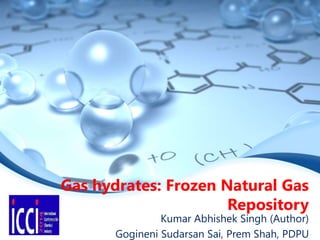
Gas hydrates icci 2014
- 1. Gas hydrates: Frozen Natural Gas Repository Kumar Abhishek Singh (Author) Gogineni Sudarsan Sai, Prem Shah, PDPU
- 2. A Fuel to Ignite India's Energy Crisis It looks like chunks of ice — but put a flame to it and it goes ablaze.
- 3. Introduction The next game-changer for the energy sector A total volume of ~1900 trillion meter cube of methane gas, stored in the form of gas-hydrates, has been prognosticated within the vast exclusive economic zone (EEZ) of India. This volume of gas is greater than 1500 times of India’s present natural gas reserve.
- 4. Agenda or Summary Layout About Gas Hydrate Technology for the exploration of Gas Hydrates Methodologies for exploitation of Gas Hydrates Gas Hydrate production, research, development Barriers AND Conclusion 1. 2. 5. 3. 4. 6. Example from KG Basin, India
- 5. About Gas Hydrate An ice-like crystalline form of water and low molecular weight gas (e.g., methane, ethane, carbon dioxide). Also phrased as "Fiery ice“.
- 6. Structural transition Gas composition and pressure effect
- 7. Where and How Does Gas Hydrate Form? Gas hydrate is stable in the underlying sediments to a depth of about 225 m below the seafloor. Also gas hydrate is stable from about 200 to 600 m within the permafrost and from 600 m to ~1100 m beneath the permafrost.
- 8. In environments in which the temperature is 0 degree Celsius, gas hydrate will form only if the atmospheric pressure is 23 times normal atmosphere (i.e., 23 atm). Under normal atmospheric pressure, gas hydrate will only exist in stable form if the temperature is -80 degree Celsius or below.
- 9. Global Occurrence & Distribution of Natural Gas Hydrates The huge volume (1-120 x 1015 m3) of methane trapped within global reserve. Location of known and inferred gas hydrate occurrences (89 sites) in deep marine and arctic permafrost environments.
- 10. India’s position If 1% of the Prognosticated potential resource which is estimated at 1894 TCM, can be exploited, the exploitable resources would give rise to 3100 TCM of methane since at standard temperature and pressure per cubic meter of hydrate yields on an average 164 m3 of methane and 0.8 m3 of water.
- 11. Technology used for the exploration of Gas Hydrates The bottom of gas hydrate stability zone (GHSZ) is strong reflector of seismic waves. This reflector is named as bottom simulating reflector (BSR) in the seismic section. Enhanced reflections below the BSR.
- 12. Confirm the presence of Gas Hydrate Microstructural model of hydrate bearing sediments.
- 13. Time to be Practical Comparison of measured and modelled seismic velocities in hydrate bearing zone of a Canadian well
- 14. Example from KG Basin, India An anomalous reflector was first identified in 1970 that mimics the sea- bottom. But since it was not twice the travel-time of acoustic signal to the sea-bottom, it could not be designated as a multiple reflection.
- 15. Confirm by borehole image and core from Krishna-Godavari region. NGHP-01-10 is one of the richest marine gas hydrate accumulations ever discovered
- 16. Methodologies for exploitation of Gas Hydrates De-pressurization and Thermal dissociation (e.g. McKenzie delta Canadian Permafrost Area (2007))
- 17. An option to reduce carbon emissions CO2 substitution
- 18. Inhibitor Injection Method Hydrophobic amino acids and methanol
- 19. Gas Hydrate production research and development USA, Japan, India, Canada, the United Kingdom, Germany, Brazil, Norway, Russia, China, Korea, etc., are the countries actively involved in research and development of gas hydrates. Mallik 2002 Gas Hydrate Well Research Programme and attempted the first gas production test. Thermal stimulation by hot water circulation was tried in the test. During the 123.7 hour operation, 470m3 gas was produced from the formation.
- 20. India’s Expedition Overview Reconnaissance surveys carried out by DGH in the East Coast and Andaman Deepwater areas in 1997 deciphered the most promising areas for Gas Hydrates. Under the National Gas Hydrate Program (NGHP), Discovered gas hydrate in numerous complex geologic settings and collected an unprecedented number of gas hydrate cores (more than 2800 m from 21 sites and 39 holes).
- 21. Barriers One reason why developing nations hesitate to invest in gas hydrate research is the resource’s uncertain economic viability. As there are not many wells drilled for methane extraction, it’s extremely difficult to assess the true amount of methane hydrate deposits. Effective heat transfer from well to the reserve.
- 22. Conclusion "How long can the gradual warming go on before the methane gets out? Nobody knows, but the longer it goes on, the closer we get to playing Russian roulette.“ If exploration moves on to gas production, the geopolitical, economic and environmental repercussions will be enormous — and developing nations could assume new positions on a transformed global energy map.
- 23. References [1] http://www.scidev.net/global/energy/feature/developing-nations- join-r-d-race-for-gas-hydrates.html [2] http://info.drillinginfo.com/gas-hydrates-keep-the-lights-on/ [3] http://www.eai.in/ref/ae/afm/afm.html [4] http://www.rdmag.com/articles/2011/06/future-fossil-fuel [5] http://www.dghindia.org/NonConventionalEnergy.aspx?tab=0 [6] http://woodshole.er.usgs.gov/project-pages/hydrates/primer.html [7]http://www.glossary.oilfield.slb.com/en/Terms.aspx?LookIn=term%2 0name&filter=gas+hydrate (8) Collet, A. Johnson, C. Knapp, and R. Boswell, eds., Natural gas hydrates—Energy resource potential and associated geologic hazards: AAPG Memoir 89, p. 146– 219. (9) Rappel, C., 2007, Tapping methane hydrates for unconventional natural gas, Elements, 3(3), 193-199.
